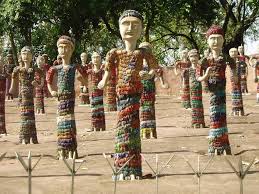The Rock Garden of Chandigarh is a world-renowned art and sculpture garden created by Nek Chand, a self-taught artist and former government road construction worker. The garden is located in Chandigarh, India, and is a stunning example of creativity, resourcefulness, and dedication. It has become one of India’s most unique and popular tourist attractions.
In 1958, Nek Chand discovered a disused plot of land in the forests on the outskirts of Chandigarh. He decided to transform this barren area into a remarkable and imaginative creation.
With no formal training in art, Nek Chand began using scrap materials, including broken ceramics, stones, glass, discarded tiles, and concrete to create sculptures and structures.
The garden spans over 12 acres (4.85 hectares) and is a maze of intricate pathways, sculptures, and structures. The landscape is designed to look like a dream world filled with unique art installations and creative representations.
It features figurative sculptures, fantastical creatures, human forms, and abstract sculptures, often blending themes of mythology, folk traditions, and nature.
Nek Chand also used natural elements like plants, water bodies, and stone formations to enhance the aesthetics of the garden.
The garden is filled with over 2000 sculptures made from recycled materials. These sculptures include human figures, animals, birds, masks, and abstract forms, all crafted with remarkable attention to detail.
Notable sculptures include dancing figures, giant faces, and representations of Indian mythology and local culture. Many of these sculptures are crafted with a sense of whimsy and surrealism, creating an immersive visual experience for visitors.
The Rock Garden is divided into several sections, each with its unique theme and design. Some sections are filled with sculpted walls, domes, archways, and courtyards, giving the garden a maze-like appearance.
Water bodies are incorporated into the layout, creating serene spaces with small streams and pools, along with waterfalls.
The garden also has a stage that has been used for cultural events and performances, adding an extra dimension to its artistic offerings.
A nursery area was also established to ensure the growth of various plants, adding greenery to complement the sculptures.
Nek Chand’s genius lay in his ability to repurpose discarded materials, which included broken glass pieces, old electrical parts, pottery shards, broken tiles, stones, pieces of mirrors, and metal scraps.
These materials were sourced from the surrounding areas and discarded by local people, yet Nek Chand transformed them into dazzling sculptures and functional structures.
The process of recycling and reusing discarded objects became a signature feature of the Rock Garden, showcasing how seemingly useless materials could be given new life through creativity.
Initially, the project was a secret, as it was built without official permission. Nek Chand worked on the garden in his spare time, often under the cover of darkness, to avoid detection.
In 1972, the garden was discovered by the authorities, and the work was legalized, allowing for further expansion and official recognition.
Over the years, the garden was expanded, with new sections being added. It has grown into a sprawling artistic masterpiece that attracts thousands of visitors each year.
Today, the Rock Garden of Chandigarh is one of the most famous tourist destinations in India, attracting visitors from around the world.
It is known for its uniqueness and innovative design, and visitors come to explore its intricate pathways, admire the sculptures, and marvel at the creativity behind its construction.
The garden also serves as a source of inspiration for artists, designers, and creators who seek to combine art, nature, and recycling in innovative ways.
The Rock Garden has earned national and international recognition for its artistic ingenuity, and Nek Chand received several accolades for his work.
The garden is often considered one of the most innovative art installations in the world, blending sculpture, architecture, and environmental design in a cohesive and imaginative manner.
Nek Chand was awarded the Padma Shri in 1984, one of India’s highest civilian honors, for his contributions to art and culture.
Nek Chand passed away in 2015, but his legacy lives on through the Rock Garden. His vision and tireless effort to create something out of discarded materials have left a lasting impact on the world of art and culture.
The Rock Garden continues to inspire future generations, showing that creativity and resourcefulness can transform even the most humble materials into works of art.
The Rock Garden is not just a tourist attraction but also a symbol of Indian culture, particularly the values of creativity and sustainability. It emphasizes the importance of artistic expression and resource management while blending local folklore and traditions.
The garden’s eclectic style and imaginative forms reflect the rich diversity of Indian art and culture, making it an iconic cultural landmark.
The Rock Garden of Chandigarh stands as a monumental achievement of vision, creativity, and resourcefulness. Created from discarded materials, it is not only an artistic wonder but also a celebration of recycling and sustainability. Today, it remains an enduring testament to Nek Chand’s passion and ingenuity, drawing millions of visitors who come to experience the beauty and creativity that thrive in a space once left abandoned.







